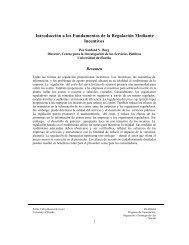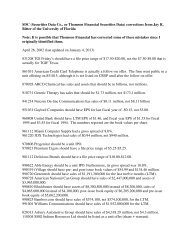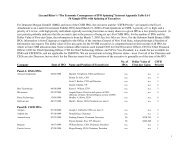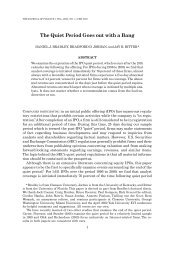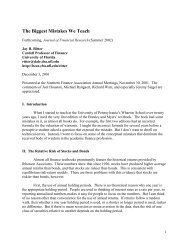Initial Public Offerings Jay R. Ritter Cordell Professor of Finance ...
Initial Public Offerings Jay R. Ritter Cordell Professor of Finance ...
Initial Public Offerings Jay R. Ritter Cordell Professor of Finance ...
Create successful ePaper yourself
Turn your PDF publications into a flip-book with our unique Google optimized e-Paper software.
investors who assist an investment banker in getting more accurate pricing. If regular investors<br />
can be favored by getting more shares in hot deals, they don’t have to be favored by underpricing<br />
as much as otherwise would be required. A dark side to the favoritism in allocation surfaced in<br />
1997 with a Wall Street Journal article, and subsequent S.E.C. investigation, alleging that<br />
underwriters competed for IPO business partly by allocating shares in hot deals to some venture<br />
capitalists and executives <strong>of</strong> private companies that were likely candidates to go public. This<br />
practice, called spinning, is intended to influence the choice <strong>of</strong> underwriter.<br />
7.2 Overallotment options and stabilization<br />
When taking a firm public using a firm commitment contract, the investment bankers will<br />
typically presell more than 100% <strong>of</strong> the shares <strong>of</strong>fered. Almost all IPOs include an overallotment<br />
option, in which the issuing firm or selling shareholders give the investment banker the right to<br />
sell up to 15% more shares than guaranteed. The overallotment option is also called the Green<br />
Shoe option, since the first <strong>of</strong>fering to include one was the February 1963 <strong>of</strong>fering <strong>of</strong> the Green<br />
Shoe Manufacturing Company. If the investment bankers expect aftermarket demand to be hot,<br />
they will typically presell 115% <strong>of</strong> the issue, with the expectation that they will exercise the<br />
overallotment option. If they expect aftermarket demand to be weak, they will typically presell<br />
135% <strong>of</strong> the <strong>of</strong>fering, with the shares above the overallotment option representing a naked short<br />
position in the stock. The advantage <strong>of</strong> preselling extra shares is that if many shares are<br />
“flipped,” that is, immediately sold in the aftermarket by investors who had been allocated<br />
shares, the investment banker can buy them back and retire the shares, just as if they had never<br />
been issued in the first place.<br />
While it is generally illegal to manipulate a stock price, manipulation is permitted directly<br />
after a securities <strong>of</strong>fering. Investment bankers have legal authority to post a “stabilizing” bid, at<br />
or below the <strong>of</strong>fer price, at which they stand ready to buy shares once trading has commenced.<br />
The existence <strong>of</strong> this floor price allows investors to get out <strong>of</strong> an <strong>of</strong>fer before the price declines,<br />
and may also head <strong>of</strong>f a larger price drop if no stabilization occurred. Stabilizing a stock is also<br />
referred to as supporting the stock.<br />
Why would an underwriter allocate extra shares (the extra 35%) to investors when it<br />
expects to buy them back, rather than just allocate fewer shares in the first place? One possibility<br />
is that some investors are willing to buy and hold the stock if they can get shares at the <strong>of</strong>fer price<br />
when these same investors wouldn’t be willing to buy these same shares at the same price in the<br />
market, once trading commences. Thus, the inclination to hold the stock may be stronger if more<br />
shares are allocated initially. Another reason may be that favored clients <strong>of</strong> the investment<br />
banker are more likely to sell back their shares, and <strong>of</strong>fering price support is a way <strong>of</strong> favoring<br />
some clients over others. Yet a third reason is that by <strong>of</strong>fering price support, the investment<br />
banker is telling investors that there are fewer incentives to overprice a deal, and this reassures<br />
investors who would otherwise not be willing to buy at the <strong>of</strong>fer price.<br />
For IPOs that are stabilized, on average the price drops by about 4% during the<br />
subsequent month (say, from a $10 <strong>of</strong>fer price to $9 5/8). For the roughly two-thirds <strong>of</strong> issues<br />
that aren’t stabilized, there is a slight uptrend in price during the month after the issue. When all<br />
21




